8.1 Studying and Encoding Memories
Please continue to the next section.
Studying Memory
memory the persistence of learning over time through the encoding, storage, and retrieval of information.
8-
Memory is learning that persists over time; it is information that has been acquired and stored and can be retrieved. Research on memory’s extremes has helped us understand how memory works. At age 92, my [DM] father suffered a small stroke that had but one peculiar effect. He was as mobile as before. His genial personality was intact. He knew us and enjoyed poring over family photo albums and reminiscing about his past. But he had lost most of his ability to lay down new memories of conversations and everyday episodes. He could not tell me what day of the week it was, or what he’d had for lunch. Told repeatedly of his brother-

At the other extreme are people who would be gold medal winners in a memory Olympics. Russian journalist Solomon Shereshevskii, or S, had merely to listen while other reporters scribbled notes (Luria, 1968). You and I could parrot back a string of about 7—
Amazing? Yes, but consider your own impressive memory. You remember countless faces, places, and happenings; tastes, smells, and textures; voices, sounds, and songs. In one study, students listened to snippets—
So, too, with faces and places. Imagine viewing more than 2500 slides of faces and places for 10 seconds each. Later, you see 280 of these slides, paired with others you’ve never seen. Actual participants in this experiment recognized 90 percent of the slides they had viewed in the first round (Haber, 1970). In a follow-
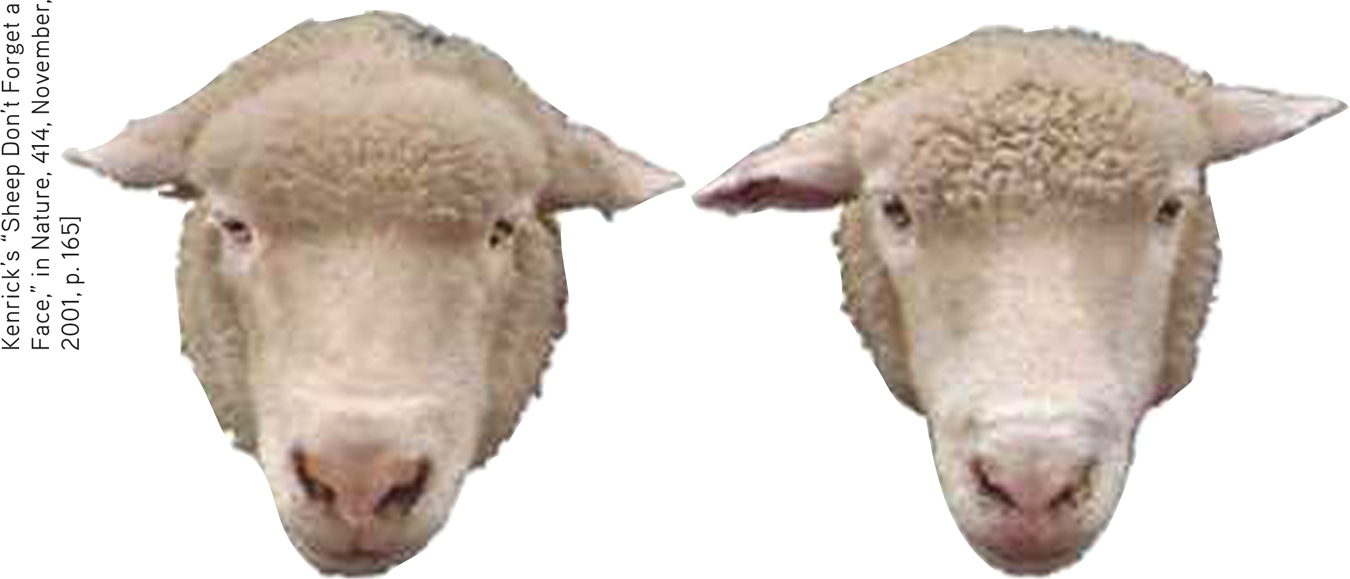
 Figure 8.1
Figure 8.1Other animals also display face smarts After repeatedly experiencing food rewards associated with some sheep faces, but not with others, sheep remember those faces for two years (Kendrick & Feng, 2011).
How do we accomplish such memory feats? How does our brain pluck information out of the world around us and tuck that information away for later use? How can we remember things we have not thought about for years, yet forget the name of someone we met a minute ago? How are memories stored in our brains? Why will you be likely, later in this chapter, to misrecall this sentence: “The angry rioter threw the rock at the window”? In this chapter, we’ll consider these fascinating questions and more, including tips on how we can improve our own memories.
319
Measuring Retention
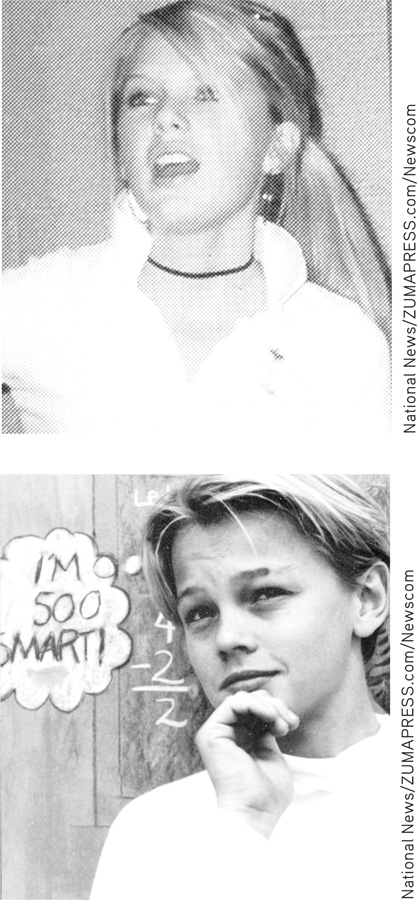
To a psychologist, evidence that learning persists includes these three measures of retention:
- recall—retrieving information that is not currently in your conscious awareness but that was learned at an earlier time. A fill-
in- the- blank question tests your recall. recall a measure of memory in which the person must retrieve information learned earlier, as on a fill-
in- the- blank test. - recognition—identifying items previously learned. A multiple-
choice question tests your recognition. recognition a measure of memory in which the person need only identify items previously learned, as on a multiple-
choice test. - relearning—learning something more quickly when you learn it a second or later time. When you study for a final exam or engage a language used in early childhood, you will relearn the material more easily than you did initially.
relearning a measure of memory that assesses the amount of time saved when learning material again.
Long after you cannot recall most of the people in your high school graduating class, you may still be able to recognize their yearbook pictures from a photographic lineup and pick their names from a list of names. In one experiment, people who had graduated 25 years earlier could not recall many of their old classmates. But they could recognize 90 percent of their pictures and names (Bahrick et al., 1975). If you are like most students, you, too, could probably recognize more names of Snow White’s seven dwarfs than you could recall (Miserandino, 1991).
Our recognition memory is impressively quick and vast. “Is your friend wearing a new or old outfit?” “Old.” “Is this five-
Our speed at relearning also reveals memory. Pioneering memory researcher Hermann Ebbinghaus (1850–
JIH, BAZ, FUB, YOX, SUJ, XIR, DAX, LEQ, VUM, PID, KEL, WAV, TUV, ZOF, GEK, HIW.
The day after learning such a list, Ebbinghaus could recall few of the syllables. But they weren’t entirely forgotten. As FIGURE 8.2 portrays, the more frequently he repeated the list aloud on Day 1, the less time he required to relearn the list on Day 2. Additional rehearsal (overlearning) of verbal information increases retention, especially when practice is distributed over time. For students, this means that it helps to rehearse course material even after you know it.
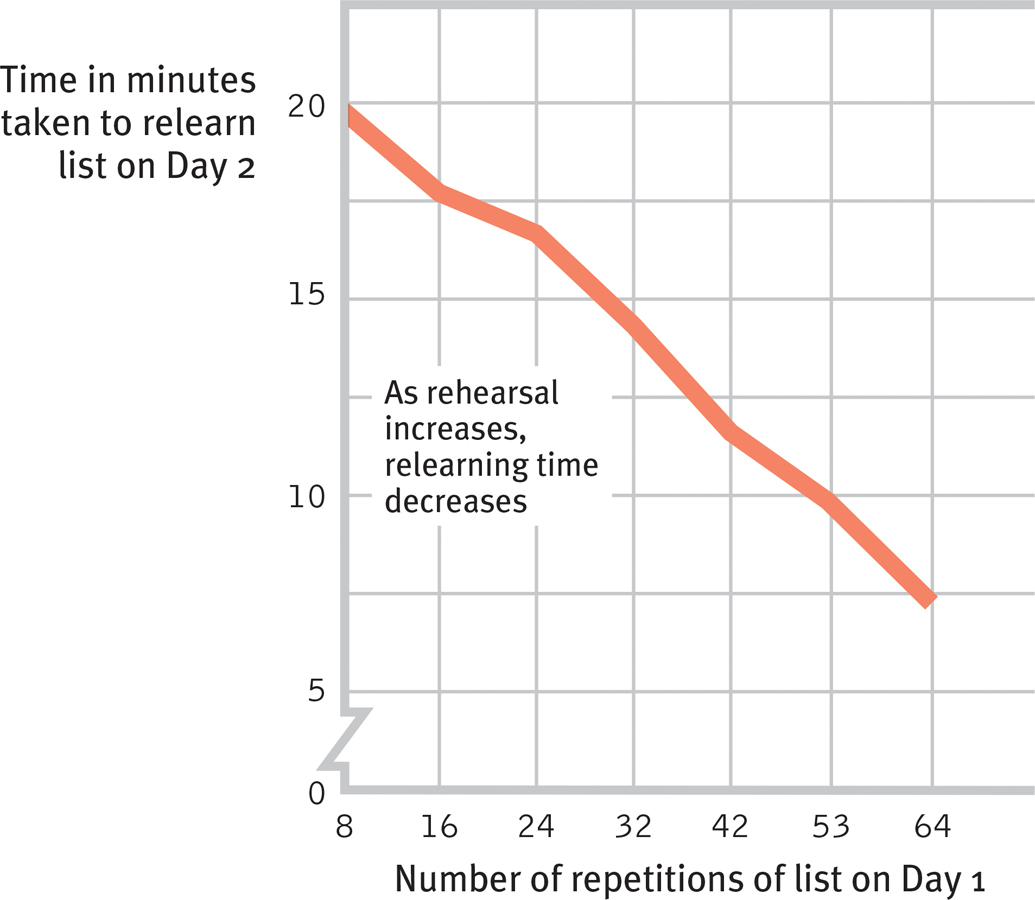
 Figure 8.2
Figure 8.2Ebbinghaus’ retention curve Ebbinghaus found that the more times he practiced a list of nonsense syllables on Day 1, the less time he required to relearn it on Day 2. Speed of relearning is one measure of memory retention. (From Baddeley, 1982.)
The point to remember: Tests of recognition and of time spent relearning demonstrate that we remember more than we can recall.
320
RETRIEVAL PRACTICE
- Multiple-
choice questions test our ______________. Fill- in- the- blank questions test our ______________.
recognition; recall
- If you want to be sure to remember what you’re learning for an upcoming test, would it be better to use recall or recognition to check your memory? Why?
It would be better to test your memory with recall (such as with short-
Memory Models
8-
Architects make miniature house models to help clients imagine their future homes. Similarly, psychologists create memory models to help us think about how our brain forms and retrieves memories. An information-
- get information into our brain, a process called encoding.
encoding the processing of information into the memory system—
for example, by extracting meaning. - retain that information, a process called storage.
storage the process of retaining encoded information over time.
- later get the information back out, a process called retrieval.
retrieval the process of getting information out of memory storage.
parallel processing the processing of many aspects of a problem simultaneously; the brain’s natural mode of information processing for many functions.
Like all analogies, computer models have their limits. Our memories are less literal and more fragile than a computer’s. Moreover, most computers process information sequentially, even while alternating between tasks. Our agile brain processes many things simultaneously (some of them unconsciously) by means of parallel processing. To focus on this multitrack processing, one information-
To explain our memory-
- We first record to-
be- remembered information as a fleeting sensory memory. sensory memory the immediate, very brief recording of sensory information in the memory system.
- From there, we process information into short-
term memory , where we encode it through rehearsal.short-
term memory activated memory that holds a few items briefly, such as the seven digits of a phone number while calling, before the information is stored or forgotten. - Finally, information moves into long-
term memory for later retrieval.long-
term memory the relatively permanent and limitless storehouse of the memory system. Includes knowledge, skills, and experiences.
Other psychologists have updated this model (FIGURE 8.3) with important newer concepts, including working memory and automatic processing.

 Figure 8.3
Figure 8.3A modified three-
working memory a newer understanding of short-
Working Memory Alan Baddeley and others (Baddeley, 2001, 2002; Barrouillet et al., 2011; Engle, 2002) extended Atkinson and Shiffrin’s view of short-
321
For most of you, what you are reading enters working memory through vision. You might also repeat the information using auditory rehearsal. As you integrate these memory inputs with your existing long-

 Figure 8.4
Figure 8.4Working memory Alan Baddeley’s (2002) model of working memory, simplified here, includes visual and auditory rehearsal of new information. A hypothetical central executive (manager) focuses attention and pulls information from long-
Without focused attention, information often fades. If you think you can look something up later, you attend to it less and forget it more quickly. In one experiment, people read and typed new bits of trivia they would later need, such as “An ostrich’s eye is bigger than its brain.” If they knew the information would be available online they invested less energy and remembered it less well (Sparrow et al., 2011; Wegner & Ward, 2013). Sometimes Google replaces rehearsal.
Question
dZF4MLDXrMy3Vi47zb/MtIS3UwbVHkqikEHFhizOSVQKgxckRZghrBMEEtQRuA3wIFbB2hy7WaE47uk5lq9Tjk6QevI4dvHbGIxo6wZIyMDXgAk0DM38yGw9PE+oc/2OvfBO0neLJD3740P8dHbFpB9dxPjCfsGlblgoaJWTvGwW6b1gqQsRet9q9jzJ8EOqIKR4WAKo0Pv91pXPwrGE1j26MnjhZYFQ/G7tmSrV87AR5OU3X6JpdmeILKw46vcbulxc2z3+d7mnn0qO8Vtihn09jbChUfJonybfXOj89A2Bm6twhuNZqN3h2sD/6oEw3GI4wUvMeDhcJRy+o7em8yXzHIMei+5JKX0T9z3uLvmMyu3mm8AzxPANTfk=RETRIEVAL PRACTICE
- What two new concepts update the classic Atkinson-
Shiffrin three- stage information- processing model?
(1) We form some memories through automatic processing, without our awareness. The Atkinson-
- What are two basic functions of working memory?
(1) Active processing of incoming visual-
Encoding Memories
Dual-
8-
 For a 14-
For a 14-
explicit memory memory of facts and experiences that one can consciously know and “declare.” (Also called declarative memory.)
effortful processing encoding that requires attention and conscious effort.
automatic processing unconscious encoding of incidental information, such as space, time, and frequency, and of well-
Atkinson and Shiffrin’s model focused on how we process our explicit memories—the facts and experiences that we can consciously know and declare (thus, also called declarative memories). But our mind has a second, unconscious track. We encode explicit memories through conscious effortful processing. Behind the scenes, other information skips the conscious encoding track and barges directly into storage. This automatic processing, which happens without our awareness, produces implicit memories (also called nondeclarative memories).
implicit memory retention of learned skills or classically conditioned associations independent of conscious recollection. (Also called nondeclarative memory.)
322
Automatic Processing and Implicit Memories
8-
Our implicit memories include procedural memory for automatic skills (such as how to ride a bike) and classically conditioned associations among stimuli. If attacked by a dog in childhood, years later you may, without recalling the conditioned association, automatically tense up as a dog approaches.
Without conscious effort you also automatically process information about
- space. While studying, you often encode the place on a page where certain material appears; later, when you want to retrieve the information, you may visualize its location on the page.
- time. While going about your day, you unintentionally note the sequence of its events. Later, realizing you’ve left your coat somewhere, the event sequence your brain automatically encoded will enable you to retrace your steps.
- frequency. You effortlessly keep track of how many times things happen, as when you realize, “This is the third time I’ve run into her today.”
Our two-
Effortful Processing and Explicit Memories
Automatic processing happens effortlessly. When you see words in your native language, perhaps on the side of a delivery truck, you can’t help but read them and register their meaning. Learning to read wasn’t automatic. You may recall working hard to pick out letters and connect them to certain sounds. But with experience and practice, your reading became automatic. Imagine now learning to read reversed sentences like this:
.citamotua emoceb nac gnissecorp luftroffE
At first, this requires effort, but after enough practice, you would also perform this task much more automatically. We develop many skills in this way: driving, texting, and speaking a new language.
Sensory Memory
8-
Sensory memory (recall Figure 8.3) feeds our active working memory, recording momentary images of scenes or echoes of sounds. How much of this page could you sense and recall with less exposure than a lightning flash? In one experiment, people viewed three rows of three letters each, for only one-
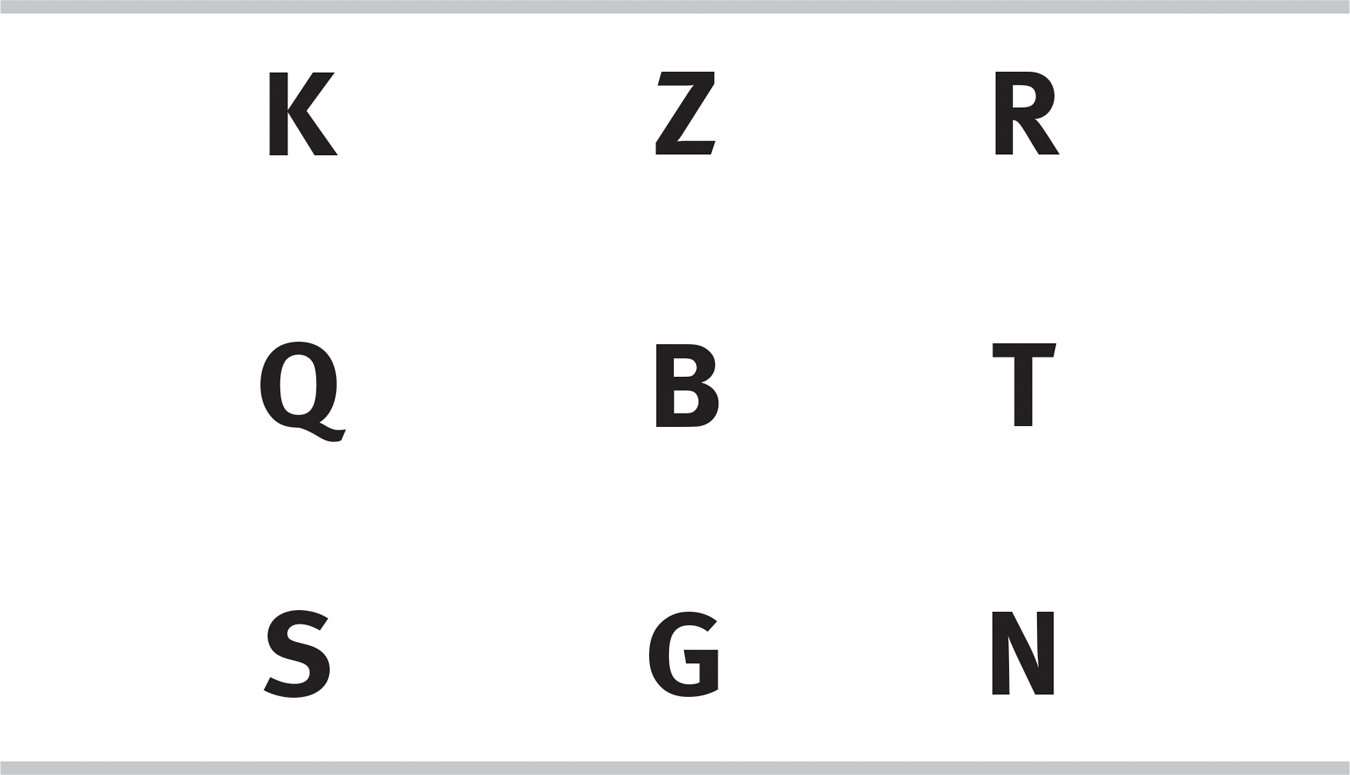
 Figure 8.5
Figure 8.5Total recall—
iconic memory a momentary sensory memory of visual stimuli; a photographic or picture-
Was it because they had insufficient time to glimpse them? No. George Sperling cleverly demonstrated that people actually could see and recall all the letters, but only momentarily. Rather than ask them to recall all nine letters at once, he sounded a high, medium, or low tone immediately after flashing the nine letters. This tone directed participants to report only the letters of the top, middle, or bottom row, respectively. Now they rarely missed a letter, showing that all nine letters were momentarily available for recall.
echoic memory a momentary sensory memory of auditory stimuli; if attention is elsewhere, sounds and words can still be recalled within 3 or 4 seconds.
323
Sperling’s experiment demonstrated iconic memory, a fleeting sensory memory of visual stimuli. For a few tenths of a second, our eyes register a photographic or picture-
We also have an impeccable, though fleeting, memory for auditory stimuli, called echoic memory (Cowan, 1988; Lu et al., 1992). Picture yourself in conversation, as your attention veers to your smartphone screen. If your mildly irked companion tests you by asking, “What did I just say?” you can recover the last few words from your mind’s echo chamber. Auditory echoes tend to linger for 3 or 4 seconds.
Capacity of Short-
8-
Recall that working memory is an active stage, where our brains make sense of incoming information and link it with stored memories. What are the limits of what we can hold in this middle stage?
After Miller’s 2012 death, his daughter recalled his best moment of golf: “He made the one and only hole-
George Miller (1956) proposed that we can store about seven bits of information (give or take two) in short-
Other researchers have confirmed that we can, if nothing distracts us, recall about seven digits, or about six letters or five words (Baddeley et al., 1975). How quickly do our short-
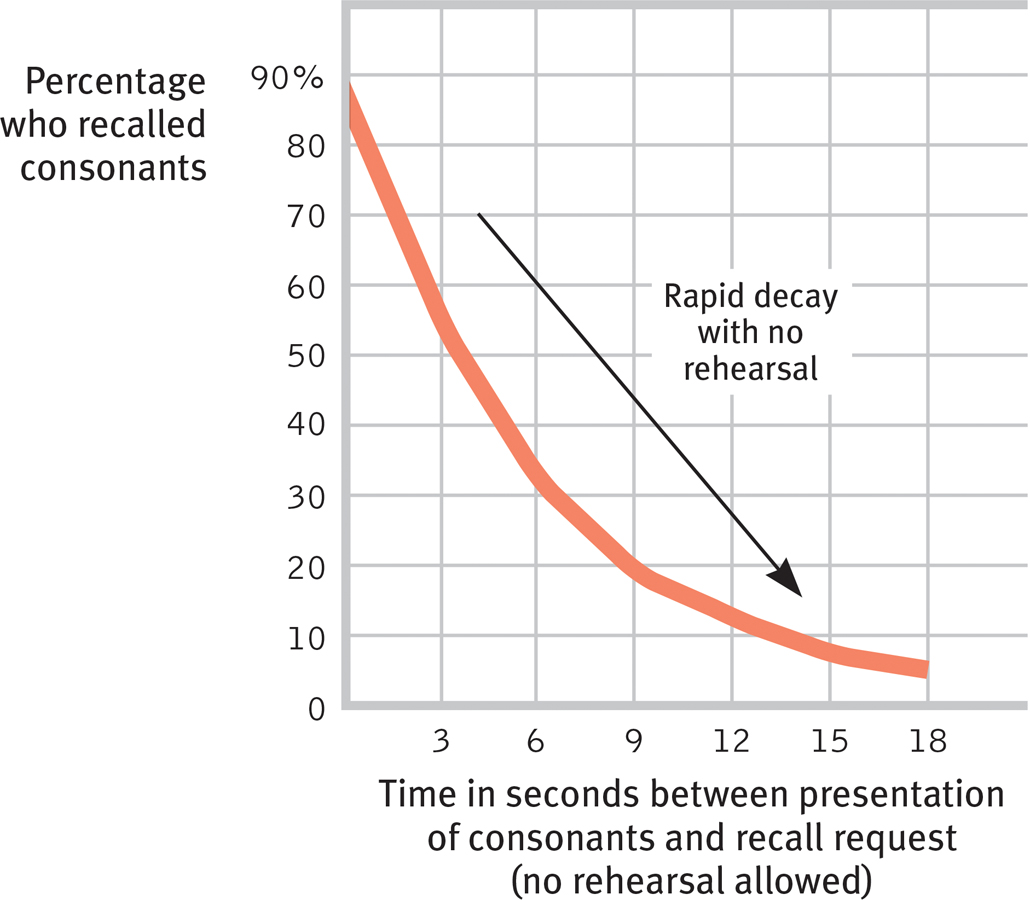
 Figure 8.6
Figure 8.6Short-
Working memory capacity varies, depending on age and other factors. Compared with children and older adults, young adults have more working memory capacity, so they can use their mental workspace more efficiently. This means their ability to multitask is relatively greater. But whatever our age, we do better and more efficient work when focused, without distractions, on one task at a time. The bottom line: It’s probably a bad idea to try to watch TV, text your friends, and write a psychology paper all at the same time (Willingham, 2010)!
324
 For a review of memory stages and a test of your own short-
For a review of memory stages and a test of your own short-
Unlike short-
RETRIEVAL PRACTICE
- What is the difference between automatic and effortful processing, and what are some examples of each?
Automatic processing occurs unconsciously (automatically) for such things as the sequence and frequency of a day’s events, and reading and comprehending words in our own language. Effortful processing requires attention and awareness and happens, for example, when we work hard to learn new material in class, or new lines for a play.
- At which of Atkinson-
Shiffrin’s three memory stages would iconic and echoic memory occur?
sensory memory
Effortful Processing Strategies
8-
Several effortful processing strategies can boost our ability to form new memories. Later, when we try to retrieve a memory, these strategies can make the difference between success and failure.
CHUNKING Glance for a few seconds at the first set of letters in FIGURE 8.7, then look away and try to reproduce what you saw. Impossible, yes? But you can easily reproduce set 2, which is no less complex. Similarly, you will probably remember sets 4 and 6 more easily than the same elements in sets 3 and 5. As this demonstrates, chunking information—
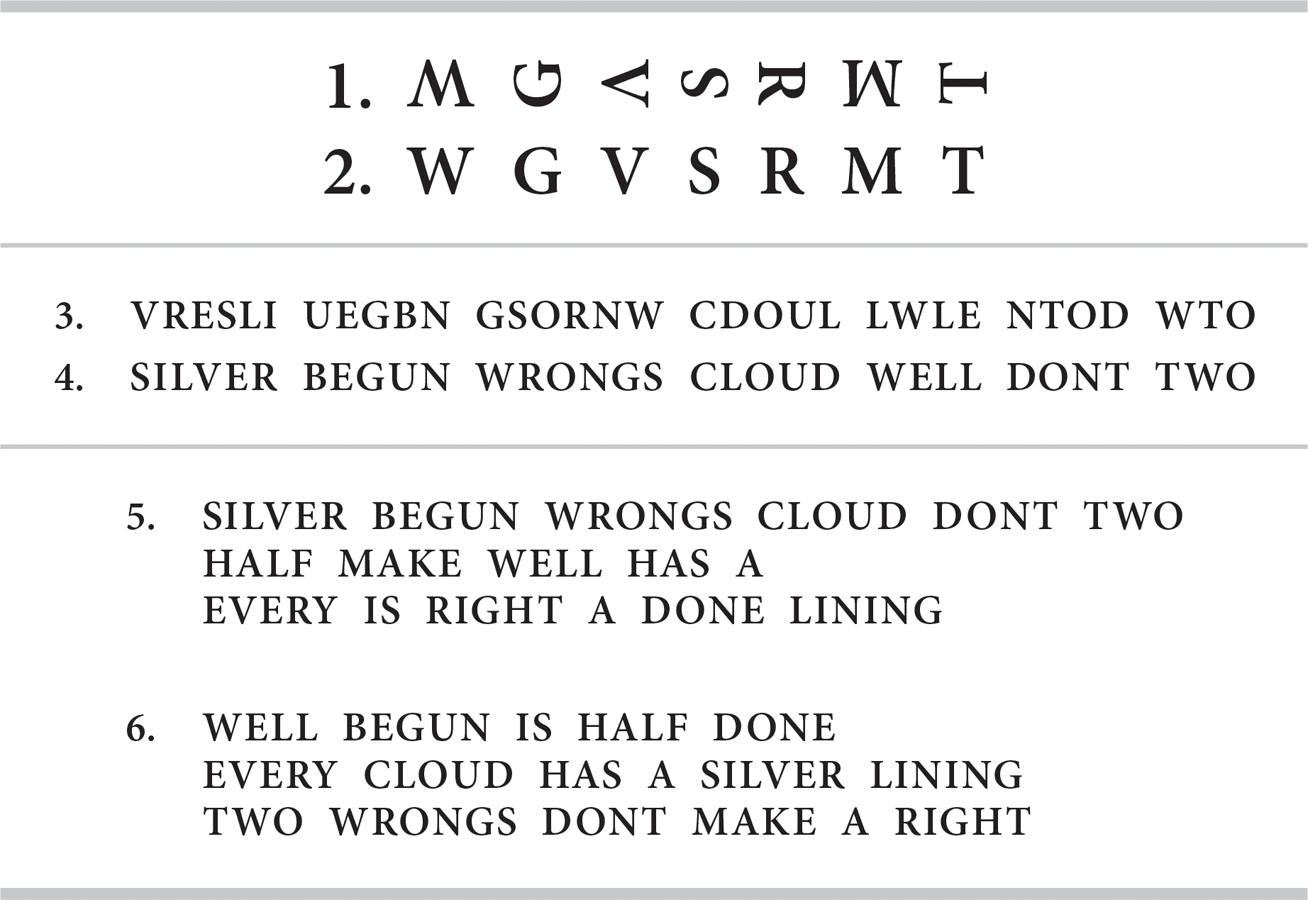
 Figure 8.7
Figure 8.7Effects of chunking on memory When Doug Hintzman (1978) showed people information similar to this, they recalled it more easily when it was organized into meaningful units, such as letters, words, and phrases.
chunking organizing items into familiar, manageable units; often occurs automatically.

 Figure 8.8
Figure 8.8An example of chunking—
mnemonics [nih-
Chunking usually occurs so naturally that we take it for granted. If you are a native English speaker, you can reproduce perfectly the 150 or so line segments that make up the words in the three phrases of set 6 in Figure 8.7. It would astonish someone unfamiliar with the language. I am similarly awed at a Chinese reader’s ability to glance at FIGURE 8.8 and then reproduce all the strokes; or of a varsity basketball player’s recall of the positions of the players after a 4-
325
MNEMONICS To help them encode lengthy passages and speeches, ancient Greek scholars and orators developed mnemonics. Many of these memory aids use vivid imagery, because we are particularly good at remembering mental pictures. We more easily remember concrete, visualizable words than we do abstract words. (When we quiz you later, which three of these words—
The peg-
spacing effect the tendency for distributed study or practice to yield better long-
When combined, chunking and mnemonic techniques can be great memory aids for unfamiliar material. Want to remember the colors of the rainbow in order of wavelength? Think of the mnemonic ROY G. BIV (red, orange, yellow, green, blue, indigo, violet). Need to recall the names of North America’s five Great Lakes? Just remember HOMES (Huron, Ontario, Michigan, Erie, Superior). In each case, we chunk information into a more familiar form by creating a word (called an acronym) from the first letters of the to-
HIERARCHIES When people develop expertise in an area, they process information not only in chunks but also in hierarchies composed of a few broad concepts divided and subdivided into narrower concepts and facts. (Figure 8.12 ahead provides a hierarchy of our automatic and effortful memory processing systems.) Organizing knowledge in hierarchies helps us retrieve information efficiently, as Gordon Bower and his colleagues (1969) demonstrated by presenting words either randomly or grouped into categories. When the words were grouped, recall was two to three times better. Such results show the benefits of organizing what you study—
Distributed Practice We retain information better when our encoding is distributed over time. More than 300 experiments over the past century have consistently revealed the benefits of this spacing effect (Cepeda et al., 2006). Massed practice (cramming) can produce speedy short-
326
Distributing your learning over several months, rather than over a shorter term, can even help you retain information for a lifetime. In a 9-
“The mind is slow in unlearning what it has been long in learning.”
Roman philosopher Seneca
(4 b.c.e.–65 c.e.)
testing effect enhanced memory after retrieving, rather than simply rereading, information. Also sometimes referred to as a retrieval practice effect or test-
One effective way to distribute practice is repeated self-
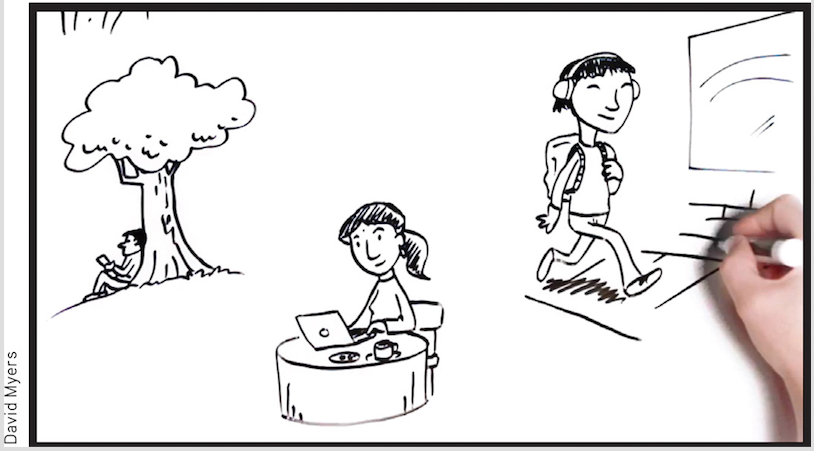
The point to remember: Spaced study and self-
shallow processing encoding on a basic level based on the structure or appearance of words.
Levels of Processing
deep processing encoding semantically, based on the meaning of the words; tends to yield the best retention.
8-
Memory researchers have discovered that we process verbal information at different levels, and that depth of processing affects our long-
In one classic experiment, researchers Fergus Craik and Endel Tulving (1975) flashed words at people. Then they asked questions that would elicit different levels of processing. To experience the task yourself, rapidly answer the following sample questions:

Which type of processing would best prepare you to recognize the words at a later time? In Craik and Tulving’s experiment, the deeper, semantic processing triggered by the third question yielded a much better memory than did the shallower processing elicited by the second question or the very shallow processing elicited by the first question (which was especially ineffective).
327
Making Material Personally Meaningful If new information is not meaningful or related to our experience, we have trouble processing it. Put yourself in the place of the students who were asked to remember the following recorded passage:
The procedure is actually quite simple. First you arrange things into different groups. Of course, one pile may be sufficient depending on how much there is to do…. After the procedure is completed, one arranges the materials into different groups again. Then they can be put into their appropriate places. Eventually they will be used once more and the whole cycle will then have to be repeated. However, that is part of life.
When the students heard the paragraph you have just read, without a meaningful context, they remembered little of it (Bransford & Johnson, 1972). When told the paragraph described washing clothes (something meaningful), they remembered much more of it—
Can you repeat the sentence about the rioter that we gave you at this chapter’s beginning? (“The angry rioter threw …”)? Here is another sentence we will ask you about later: The fish attacked the swimmer.
Perhaps, like those in an experiment by William Brewer (1977), you recalled the sentence by the meaning you encoded when you read it (for example, “The angry rioter threw the rock through the window”) and not as it was written (“The angry rioter threw the rock at the window”). Referring to such mental mismatches, some researchers have likened our minds to theater directors who, given a raw script, imagine the finished stage production (Bower & Morrow, 1990). Asked later what we heard or read, we recall not the literal text but what we encoded. Thus, studying for an exam, you may remember your lecture notes rather than the lecture itself.
We can avoid some of these mismatches by rephrasing information into meaningful terms. From his experiments on himself, Ebbinghaus estimated that, compared with learning nonsense material, learning meaningful material required one-
Psychologist-
We have especially good recall for information we can meaningfully relate to ourselves. Asked how well certain adjectives describe someone else, we often forget them; asked how well the adjectives describe us, we remember the words well. This tendency, called the self-
The point to remember: The amount remembered depends both on the time spent learning and on your making it meaningful for deep processing.
Question
kuglu9zcmXv4vzBm9iKBwCSb2i9RhHMWgDqD53NjFv9RVtImsC3YmoTUvnab9kXTHttCEyR2zygj7ri/KpjxHyIg4Pc5agi0f9Qp0BO0ML/fgA795LVKWX2xy0BY5gBmKqGs2WHwLk6Ox860+uhYvo3nU+IN96KeTlsN+On8BsbvL4TE/QCm2xebAtrhkSpIqwX8W1Y4MgLC7X+00aoKVp0qk68doMi5D4/uz2K0GR0krFdGXKD26JbcU4o2JekiaDNewP92rHCBMq0dpyH1JWjv3+ZwX8D13hFvhzdfUKo27/hFS58g0YBispw=RETRIEVAL PRACTICE
- Which strategies are better for long-
term retention: cramming and rereading material, or spreading out learning over time and repeatedly testing yourself?
Although cramming may lead to short-
- If you try to make the material you are learning personally meaningful, are you processing at a shallow or a deep level? Which level leads to greater retention?
Making material personally meaningful involves processing at a deep level, because you are processing semantically—based on the meaning of the words. Deep processing leads to greater retention.
328